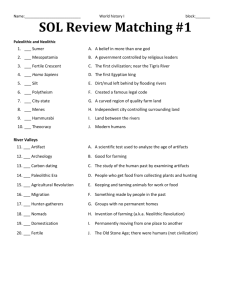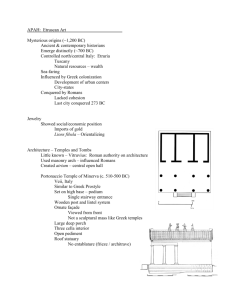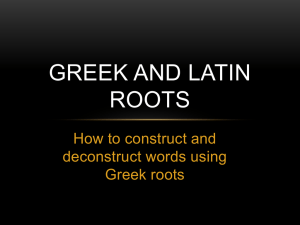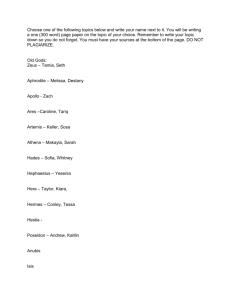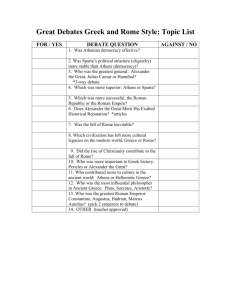Roman Sculpture - sabresocials.com
advertisement
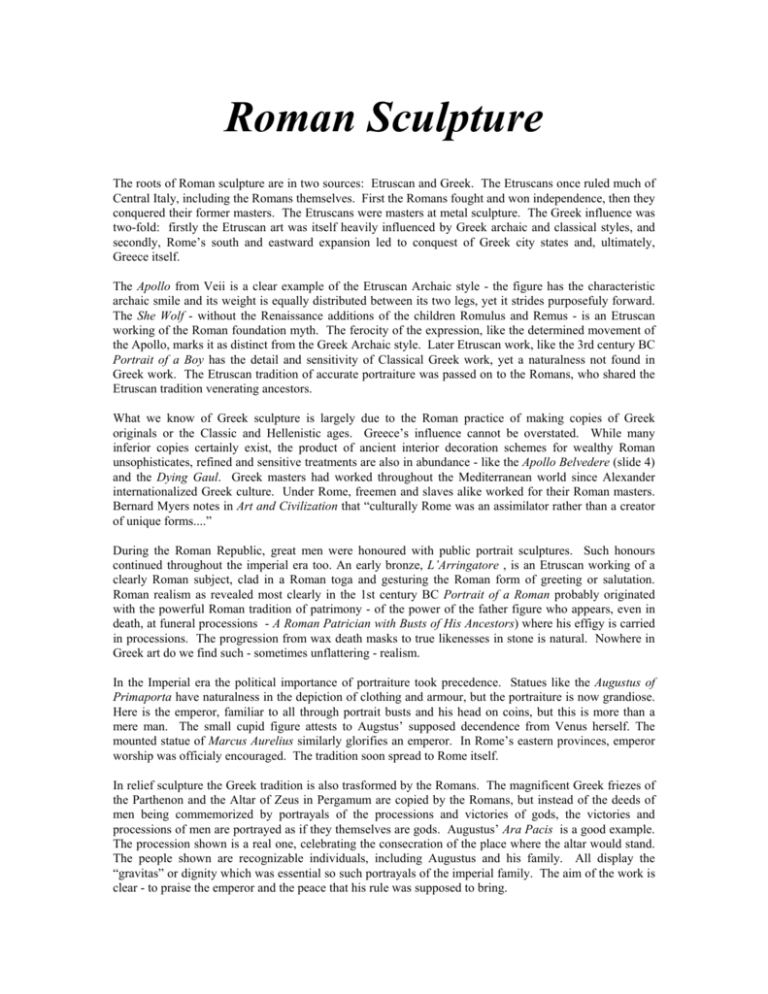
Roman Sculpture The roots of Roman sculpture are in two sources: Etruscan and Greek. The Etruscans once ruled much of Central Italy, including the Romans themselves. First the Romans fought and won independence, then they conquered their former masters. The Etruscans were masters at metal sculpture. The Greek influence was two-fold: firstly the Etruscan art was itself heavily influenced by Greek archaic and classical styles, and secondly, Rome’s south and eastward expansion led to conquest of Greek city states and, ultimately, Greece itself. The Apollo from Veii is a clear example of the Etruscan Archaic style - the figure has the characteristic archaic smile and its weight is equally distributed between its two legs, yet it strides purposefuly forward. The She Wolf - without the Renaissance additions of the children Romulus and Remus - is an Etruscan working of the Roman foundation myth. The ferocity of the expression, like the determined movement of the Apollo, marks it as distinct from the Greek Archaic style. Later Etruscan work, like the 3rd century BC Portrait of a Boy has the detail and sensitivity of Classical Greek work, yet a naturalness not found in Greek work. The Etruscan tradition of accurate portraiture was passed on to the Romans, who shared the Etruscan tradition venerating ancestors. What we know of Greek sculpture is largely due to the Roman practice of making copies of Greek originals or the Classic and Hellenistic ages. Greece’s influence cannot be overstated. While many inferior copies certainly exist, the product of ancient interior decoration schemes for wealthy Roman unsophisticates, refined and sensitive treatments are also in abundance - like the Apollo Belvedere (slide 4) and the Dying Gaul. Greek masters had worked throughout the Mediterranean world since Alexander internationalized Greek culture. Under Rome, freemen and slaves alike worked for their Roman masters. Bernard Myers notes in Art and Civilization that “culturally Rome was an assimilator rather than a creator of unique forms....” During the Roman Republic, great men were honoured with public portrait sculptures. Such honours continued throughout the imperial era too. An early bronze, L’Arringatore , is an Etruscan working of a clearly Roman subject, clad in a Roman toga and gesturing the Roman form of greeting or salutation. Roman realism as revealed most clearly in the 1st century BC Portrait of a Roman probably originated with the powerful Roman tradition of patrimony - of the power of the father figure who appears, even in death, at funeral processions - A Roman Patrician with Busts of His Ancestors) where his effigy is carried in processions. The progression from wax death masks to true likenesses in stone is natural. Nowhere in Greek art do we find such - sometimes unflattering - realism. In the Imperial era the political importance of portraiture took precedence. Statues like the Augustus of Primaporta have naturalness in the depiction of clothing and armour, but the portraiture is now grandiose. Here is the emperor, familiar to all through portrait busts and his head on coins, but this is more than a mere man. The small cupid figure attests to Augstus’ supposed decendence from Venus herself. The mounted statue of Marcus Aurelius similarly glorifies an emperor. In Rome’s eastern provinces, emperor worship was officialy encouraged. The tradition soon spread to Rome itself. In relief sculpture the Greek tradition is also trasformed by the Romans. The magnificent Greek friezes of the Parthenon and the Altar of Zeus in Pergamum are copied by the Romans, but instead of the deeds of men being commemorized by portrayals of the processions and victories of gods, the victories and processions of men are portrayed as if they themselves are gods. Augustus’ Ara Pacis is a good example. The procession shown is a real one, celebrating the consecration of the place where the altar would stand. The people shown are recognizable individuals, including Augustus and his family. All display the “gravitas” or dignity which was essential so such portrayals of the imperial family. The aim of the work is clear - to praise the emperor and the peace that his rule was supposed to bring. Glorification of the emperor was also the aim of relief sculptures found on triumphal arches erected in Rome. Architectural in scale, these arches had no real function except to be visible reminders of the greatness of the individuals they were erected to commemorate. The Arch of Titus was erected shortly after the emperor’s death, celebrating his victory over the zealot uprising in and around Jerusalem in 70 AD. Relief sculptures show Titus departing Jerusalem with looted treasures in tow . This tradition was carried on for centuries, with the Arch of Constantine serving precisely the same purpose more than two centuries later. Though even grander in scale, the ability of Roman workmen to carry out the task at the time is brought into question by the pillaging of parts of earlier works to complete the design. Whole reliefs were taken from elsewhere, the emperor’s head re-worked to resemble Constantine, and placed upon the new arch. The newly carved relief contrast sharply with the stolen circular images, lacking the life and vigour of the earlier work. An odd and rather puzzling monumental sculpture was commissioned to celebrate the victories of the emperor Trajan across the Danube in Dacia. Over 15 meters high and originally crowned by a statue of the emperor, this column sported a spiral frieze up its entire height. Unravelled and stretched out, the image would be over 200 meters in length. It is not unlike an unraveling rotulus, the scroll books used at the time. Trajan himself appears 70 times in the unfolding narration. Strangely, the entire work cannot be read, since it is impossible to follow it around and around without losing sight of the upper registers. Even looking from the two story public buildings extant at the time of its construction, it is impossible to see the entire work clearly. Because of the problem of shadow obscuring parts, the sculptor here carved less deeply into the stone and renders all but the key figures in almost schematic fashion. Realism is lost for the sake of narration. Janson (History of Art) sees this as almost foreshadowing Medieval art. In the later years of the empire in the West, interest in realism waned. The simplistic figures carved for Constantine’s arch and the huddled figures of The Four Tetrarchs are far more crude than earlier works. The mindset had clearly changed. The clear-sighted and super-confident attitudes of Rome at its imperial height had been lost. What would ultimately replace it was an ideology that placed not the emperor and the state at its center, but something entirely otherworldly. Christianity and its belief in the significance of the next life and its primacy over this one would create a new artistic sensibility.
